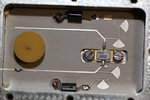Follow along with the video below to see how to install our site as a web app on your home screen.
Note: This feature may not be available in some browsers.
hi expert,
may i an actual application for Dielectric Resonator ? what is it advantageous features?
many thanks

Dear Jiripolivka,
"Like with quartz crystals (and a bit easier), you can grind the puck to move the resonant frequency...."
Yeah, this has been one of my first try. First grind, then try the frequency by loosely coupling the pill to a small coil out of the tracking generator of the spectrum analyzer and read the difficult to see dip. But when you place and glue the "pill" in the box you get a different frequency.
Second try : I've placed and glued the "pill" on the box, screwed (twelve), tested the frequency, unscrewd ,grind, screw, test frequency and so on ... Sometime, may be the damned pill don't like me and became dead...
This is the reason about the luck I was talkin before.
With the quartz it was much more easy : grind with toothpaste for an higher frequency, paint carefully with graphite to lower the frequency